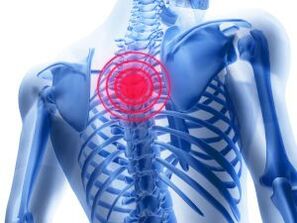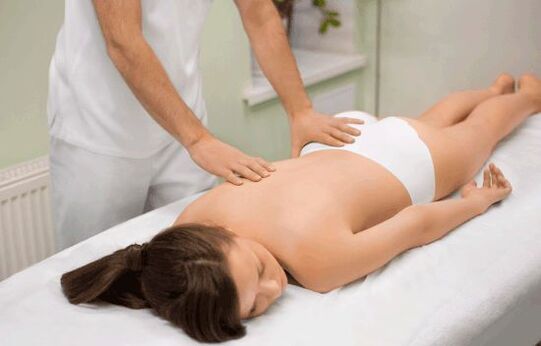
Clinically, chest osteochondrosis (chondrosis) manifests itself in the form of acute, stinging or dull, aching pains, cracking and bending during bending, and stiffness.
In the case of pathology, the characteristic and many specific symptoms of inhalation are lack of air, discomfort of the heart area and even sore throat.
Treatment of pathology with predominantly conservative pharmacological drugs. They also perform physiotherapy procedures, massages and use chiropractors.
If such treatment is ineffective, the patient undergoes surgery.
Details of symptoms
Symptoms of osteochondrosis of the thoracic spine never appear at the same time. In the initial stages of the development of this degenerative-dystrophic pathology, only a slight discomfort is observed in the back. Patients take them for banal fatigue after a tiring day of work, describing muscles that are "numb" due to their long stay in one position of the body.
But the intensity of the inconvenience is slowly, steadily increasing. Discomfort is replaced by severe pain complicated by limited movement, dizziness, and headache. In medicine, all the symptoms of osteochondrosis of a given localization are divided into several groups. This helps to diagnose and determine treatment tactics more quickly.
For a note!Symptoms of chest osteochondrosis in men and women do not differ in nature, severity, or localization. But in the stronger sex, they can occur a little later because of the stronger musculoskeletal system. In addition, some men suffer from erectile dysfunction in the background of osteochondrosis.
Vertebral symptoms
Due to unfavorable factors (hypothermia, increased physical activity), long-term remission of thoracic osteochondrosis can be interrupted by a sudden onset of acute pain. Even more often, it provokes a long stay in one position of the body, such as a sitting position. If a person suddenly gets up, there is such sharp pain in his back that he loses the ability to move for a few minutes.
In medicine, this condition is called dorsago. It differs from normal pain in concomitant symptoms:
- lack of air when inhaled;
- severe stiffness.
The course of the pathology is often complicated by dorsalgia pain in the chest spine, the intensity of which gradually increases. It grows with bending, turning the body sideways. In order not to experience pain, a person takes a state of urgency. At the same time, it involuntarily tightens the back muscles, inadvertently provoking their overvoltage. Now they start to hurt, especially while walking.
Extravertebral symptoms
With the development of chest osteochondrosis, the intervertebral discs become thinner and are destroyed. These cartilaginous inserts can no longer distribute the loads that arise, precluding the vertebrae from colliding with each other. The compensatory reaction of the body is activated - the bone structures begin to deform as growth develops. They push on sensitive nerve endings, damaging the spinal canal. Therefore, there are specific symptoms of chest osteochondrosis in women and men: loss of sensitivity in certain parts of the body, a burning sensation, and creeping "goosebumps. "
Important! Chest osteochondrosis is often manifested by dry, infertile cough, sore throat, feeling of coma, and urinary tract disorders.
But that's not all. Spinal roots are responsible not only for nerve innervation (transmission of nerve impulses) but also for internal organs. Therefore, when they are violated, unpleasant sensations occur in the liver, kidneys, digestive system, heart muscle. What are the signs of back disease in osteochondrosis of the chest:
- pain in the heart, identical to recurrence of angina pectoris, shortness of breath, feeling of "compression" of the heart;
- panic attacks, psycho-emotional instability, unfounded fear, anxiety, sleep disturbances;
- discomfort in the epigastric region, nausea, sometimes vomiting, sour belching, bloating, bloating, and rumbling;
- peristaltic disorders - constipation or diarrhea;
- prolonged, tired breathing with sobs.
Pain is not localized directly at the site of the destroyed intervertebral disc and / or the formed intervertebral hernia. They radiate during the nerve. Signs of osteochondrosis of the thoracic region may include symptoms of renal colic, gastritis, gastric ulcer, hepatitis, pancreatitis, cholecystitis, and even gastroenteritis.
Compression myelopathy
This is the name of extravertebral syndrome, which is rare in clinical practice. It is observed in stages 3-4 of the disease, when the nucleus pulposus extends beyond the annulus fibrosis due to the loss of stability of the vertebral segment. An intervertebral hernia develops that continuously presses on the spinal cord. At a meeting with a vertebrologist or neurologist, patients complain of frequent belt pain radiating to the groin area. However, there is a feeling of weakness, numbness in the lower extremities.
Against the background of spinal cord injury, innervation is severely disrupted. In the absence of treatment, the functional activity of organs located in the pelvis decreases. Compressive myelopathy causes problems with bowel movements. And due to the pronounced narrowing of the diameter of the spinal cord, the sensitivity of the legs is lost. In severe cases, patients are diagnosed with paresis (partial or complete paralysis) of one or two lower limbs.
Symptoms of remission
Apart from relapses, chest osteochondrosis hardly bothers a person. Occasionally there is a pulling, sore, dull back pain that usually disappears after a long rest. But you may want to at least slightly increase your spine load, lift a heavy object, or bend as the next relapse ensues. Such factors can trigger:
- stressful situations, depressed states;
- hypothermia, sudden changes in temperature;
- long stay in one position of the body;
- alcohol abuse;
- unbalanced diet, lack of foods rich in calcium, phosphorus, manganese, molybdenum in the diet.
Sometimes the remission phase ends because a person tries to avoid another relapse. He visits a chiropractor or massage therapist with a dubious reputation or little practical experience. An attempt to stretch the spine leads to another aggravation.
The main methods of treatment
A complete cure for the pathology is not yet possible, so every effort by physicians is aimed at improving patient well-being. Patients are advised to wear orthopedic products (corsets, bandages) that fix the structure of the vertebrae and prevent them from moving. Medicines for different clinical and pharmacological groups are prescribed, physiotherapeutic measures and physiotherapy practices are performed.

The movements of the chiropractor’s hands are aimed at increasing the gaps between the vertebrae, which decrease in osteochondrosis of the chest.
Important!In cases of severe chest osteochondrosis, conservative treatment is useless. Patients are immediately offered surgery - excision of an intervertebral hernia, arthrodesis, placement of implants instead of a damaged plate, bone replacement.
Drug therapy
The goal of treating osteochondrosis of the thoracic spine is to eliminate all symptoms and inhibit destructive and degenerative processes. During the exacerbation periods, solutions for parenteral administration are used, which show an effect after 5-10 minutes. The result is then solidified by preparing tablets using ointments and gels. In the remission phase, mainly external active ingredients are used, which have a more gentle effect on the body.
Non-steroidal anti-inflammatory drugs (NSAIDs)
This is the most commonly used class of drugs in the treatment of chest osteochondrosis complex. Its active ingredients block the biosynthesis of mediators of pain, inflammation and fever from arachidonic acids. Even after a single use of NSAIDs, a person's well-being improves significantly:
- the severity of the pain syndrome decreases;
- the unpleasant crackling that occurs when the body turns and tilts disappears;
- the inflammatory processes in the soft tissues are weakened, the edema disappears;
- the range of motion increases in the chest region.
Intramuscular solutions are used to stop relapses. Formulations of capsules or tablets are able to cope with moderate pain. And ointments and gels quickly eliminate mild discomfort.
Preparations containing vitamins B.
Formulations containing group B vitamins cope well with innervation disorders, improve the transmission of nerve impulses to the central and peripheral nervous system, and stimulate the recovery of damaged spinal roots. The composition of the bases is represented by thiamine, riboflavin, pyridoxine, cyanocobalamin.
During the first week of therapy, intramuscular administration of drugs that contain lidocaine in addition to vitamins is practiced, which immediately eliminates the pain. Then, for a month, the patients take pills.
Glucocorticosteroids
The use of these synthetic analogs of hormones, which are produced by the adrenal glands, is practiced when safer devices are ineffective. Glucocorticosteroids are prescribed to patients who have acute, prickly back pain and radiate to internal organs. The drugs can be taken orally, but more often parenterally, including at the site of discarded plates.
Glucocorticosteroids have a number of contraindications and possible side effects. Long-term treatment of chest chondrosis with hormones leads to damage to liver, kidney, and stomach tissues. Thus, their use is contraindicated in patients with cirrhosis, peptic ulcer disease, renal failure and osteoporosis.
Muscle relaxants
Back pain is often attributed to increased skeletal muscle tone. To relax this, muscle relaxants are used - first in the form of solutions for parenteral administration and then in tablets. Medications relieve muscle cramps that cause the spinal cord to compress. What are the most effective muscle relaxants:
- blocks polysynaptic reflexes;
- relaxation of spasmodic muscles;
- reduces the release of prostaglandins.
Drugs are rarely used in monotherapy. Treatment of chest chondrosis is performed in combination with muscle relaxants, glucocorticosteroids, or non-steroidal anti-inflammatory drugs. Their significant disadvantage is that the addiction develops fairly quickly, so it is forbidden to use them for more than a week.
Chondroprotectors
Unlike drugs that relieve the symptoms of chest osteochondrosis, these drugs are also used for pathogenetic therapy. It is the only group of drugs that can increase the production of chondrocytes that are required for the partial restoration of cartilage intervertebral discs. All therapeutic effects of chondroprotectors are due to the high content of glucosamine and / or chondroitin.
But chondroprotectors are valued not only for their ability to recover plates. Their parts glow in the area of the injured vertebral segment. After 2-3 weeks, the maximum therapeutic concentration of glucosamine and chondroitin is reached. Now the drugs show pronounced analgesic, anti-inflammatory and anti-edematous activity.
Recommendation!It is preferable to treat osteochondrosis with chondroprotectors in the form of solutions or tablets for injection. Although the manufacturers provided all assurances about the effectiveness of ointments and creams, they could not provide evidence of their therapeutic effectiveness.
Non-pharmacological treatment
Treatment of osteochondrosis of the thoracic region with pharmacological drugs must be combined with regular physical education. Movement therapy is the most effective therapeutic method to avoid disability. Thanks to daily training, the musculoskeletal system of the back and the ligament region of the thoracic region are strengthened, and the production of synovial fluid, which feeds the vertebral structures, is improved. The set of exercises is determined by the physical therapist after studying the results of the X-ray diagnostics. Present in the first hours, monitors the dosage of loads.
Manual therapy for osteochondrosis is also practiced to increase the gaps between the plates and the vertebrae. Dry or underwater pulling (pulling) of the spine is performed and at home - hanging on the rod. The effectiveness of manual therapy increases with the simultaneous implementation of physiotherapy:
- electrophoresis;
- laser therapy;
- magnetotherapy;
- ultraviolet radiation;
- diadynamic currents.
Patients present 10-15 classic, vacuum, Scandinavian, acupressure treatments. Also useful are hirudotherapy, acupuncture, radon and hydrogen sulfide bath treatments.
Only an integrated approach to the treatment of thoracic osteochondrosis can rule out further plate damage and vertebral deformity. Following your doctor’s recommendations will help you get rid of all the symptoms of your chronic pathology as soon as possible.













































